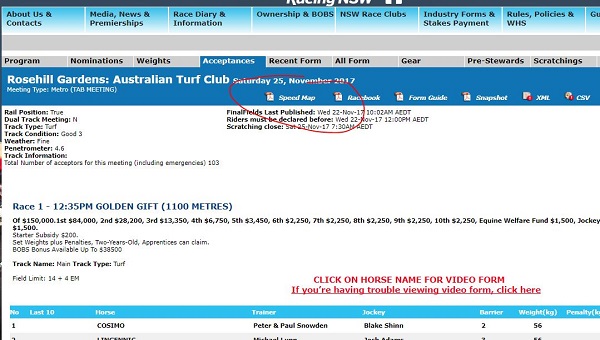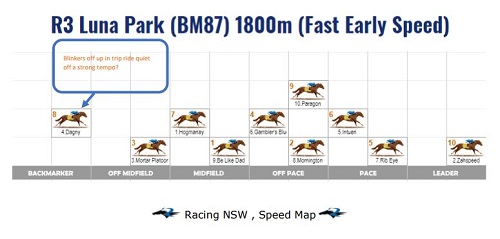Latest News
Punting Pros is an eight-part series aimed at educating punters to help take their wagering aptitude to the next level. Brad Gray sought the insights of five of the most respected industry figures when it comes to punting, form analysis and bookmaking.
- Trusting Your Eye
- Barrier Trials
- Speed Maps
- Jockeys And Trainers
- Favourite Types Of Races To Bet In
- If A Punter Has 10mins To Do The Form…
- Sectionals
- Parting Advice
Speed maps are a big part of a modern day punter’s arsenal allowing for analysts to predict a horse’s position in running. However, like punting as a whole, it’s not an exact science and there is no right or wrong way. As you’ll find out from the below there are still plenty of ways to come to a wagering conclusion.
Dominic Beirne (@domran)
In addition to mapping on a grid where each horse will be relative to the other horses, I quantify the speed compared to a standard, and by doing that I get a much fuller impression of how the race will play out, as well as the challenge that faces all of the runners and the jockeys. I use speed maps to interpret how a race will be run, where the horses will be relative to each other and the race shape that will unfold to find out who is best suited. The speed map grid provides the race profile, and we know the profile of all the horses and its then down to finding the runners with profiles that fit that of the race.
There is a definite relationship in Australian racing with horses closer to the lead having a higher finishing position. So yes, there is better opportunities in regards to backing winners towards the front of the race. Having said that, there are speed maps that look poisonous to leaders where you want to back the horse towards the tail. Those two statements are price/value dependant. It’s rare to want to back a favourite that looks poison on a speed map but I will be quite forgiving of decent priced horses that don’t have a favourable speed map. I’m not going to forgo an opportunity to bet at a good price if it’s value for all of the other factors. If all the other factors amount to a horse being true value I won’t let the speed map or barrier deny me a bet on the horse.

RNSW publish stewards speed maps for metro meetings
Rob Waterhouse (@RobWaterhouse)
The tricky part is getting the speed map right, that’s the hard part. Simply, the most important thing is to work out how much speed will be in the race and that’s a large part of it.
I reckon I’ve done speed maps for 30 years and used to spend lots of time doing them and then I experimented 20 years ago with computers using pace ratings. Now the computer does a better job without me even thinking about them.
People are quick to put people in categories and most say that I like leaders but I have great success in betting in races with lots of pace and finding backmarkers. I just like the horses that have got the biggest advantage. Often they’ll be leaders but sometimes not.
Nathan Snow (@snowbet)
I’m big on speed maps. They are one of the key pillars of how I do the form. Mainly because in modern racing there is so little between the horses after the handicaps. The fields are very competitive and there are always a number of horses that can win each race so therefore run of the race becomes really important. As a general rule the faster the pace the more it is going to suit backmarkers and vice versa but this isn’t always the case. This is where knowing horses as individuals, what they are suited to and how they like to be ridden, comes into play.
There is something called the shape of the race – will a horse be in a good spot, bad spot, following good horses, following bad horses? They are all individuals so each horse will be better suited under different scenarios - it’s just knowing what they are suited to and what the race is likely to look like. You can get maps drawn up but they are never exact. It’s all about getting a feel of where they are going to be and what is more likely to happen than not.
I always start with the front and the gates and then behind them you flop them out from inside to out. Most trainers are more positive from inside draws and negative from outside draws. It’s just the way they are conditioned. I do my video review first then I’ll do the map and then delve into the form.
I am flexible but there is a lot of merit in being up and out of trouble especially if they are fit and ready. Designated leaders themselves I’m not real rapped on because they can be one dimensional. I love a horse capable of stalking with good gate speed that can take a sit and be tractable.

Speed maps come in many different forms
Daniel O’Sullivan (@TRBHorseRacing)
They are the first step in everything. I’m not one to go to the enth degree of plotting where I think a horse will definitely settle. I prefer to look at maps from the perspective of 150m after the start and roughly where each horse is likely to be.
Across the line, which horses will get easy runs without the jockey making any decisions, which jockeys are going to face the need to make an early tactical decision and which horse looks like settling further forward or back than what we typically see. Obviously I am interested in potential pressure but once I’ve established the very front and the very back I tend not to worry about the ones in between, just noting who might face tough decisions. It’s so speculative and can all change as soon as the gates open.
Going back 12-13 years now my number one thing was to primarily focus on on-pace and handy horses and put a line through backmarkers. If I really liked a backmarker that doesn’t mean I’d look to bet against it, I’d just usually move onto the next race. These days, with the benefit of more experience, I am more flexible especially if I think the track pattern is suitable but as an underlying principal for a long time, I’ve been about on pace, handy. That was the thing that elevated me to the punter I am now. I went from being like the large majority of people somewhere between small losses and small wins but once I honed in on that, I took massive steps forward.
A lot of it is discipline. If you really like a horse for whatever reason and it is going to settle back – to have the discipline to pass on them. I went through a process for probably about five years where I kept a very simple record of those horses that I passed on purely on the basis of running style and those horses lost money and that was the final factor that decided it for me. It reaffirmed that I was doing the right thing. It proved beyond doubt that you are better off avoiding those horses.
John Walter (@J_Walter23)
It’s probably the most important thing these days. Maps are a lot harder to get right than people give them credit for though. If you could have the first 200m of every race on a piece of paper and you weren’t challenging Warren Buffett, there would be something wrong. It’s a huge key to racing.
I look at the race and get a feel for where horses are at in their preparation and then do a map rather than trying to guess off previous speed they have shown. So for a horse that has drawn wide but has got a good fitness base it has a bigger chance of going forward than a horse that is fresh or has had a gap between runs.
Every race has a winner and every track has a different position where you want your horses to be. Every race is different and if you don’t treat it that way you are passing on a lot of opportunities if you are discounting horses out the back. You might want a better price about those horses and be aggressive on your pricing against them because of where they are going to be in the run, and I’ve got no problem with that. There are too many dominant horses that are going to get conditions to suit back in the field that win to put a line through them all. I’m pretty flexible. I do prefer to find horses on speed, it’s much less painful, but they are not always there.
It’s a deadest charge of the light brigade in some of the country races. It’s crazy how hard they go and if you are backing leaders all the time your horses get barbequed so often that it’ll drive you mad. They tend to go a lot slower in town. I don’t know what it is. Country racing is run truly and can be harder to predict but in the city once they have found their spot they tend to hold them.
Racing NSW - home of live racing, fields and form, replays and the latest racing news
John Schell's Tips For Beaumont Newcastle (Tuesday)
Read More
Minervini Eyeing Farm Breakthrough With Fresh Shall Be
Read More
Enniroc Due For Change Of Luck At Beaumont (Tuesday)
Read More
Jockey Overweight - Warwick Farm (Wednesday)
Read More
Punter's Intelligence Wrap - The Ingham Race Day
Read More

